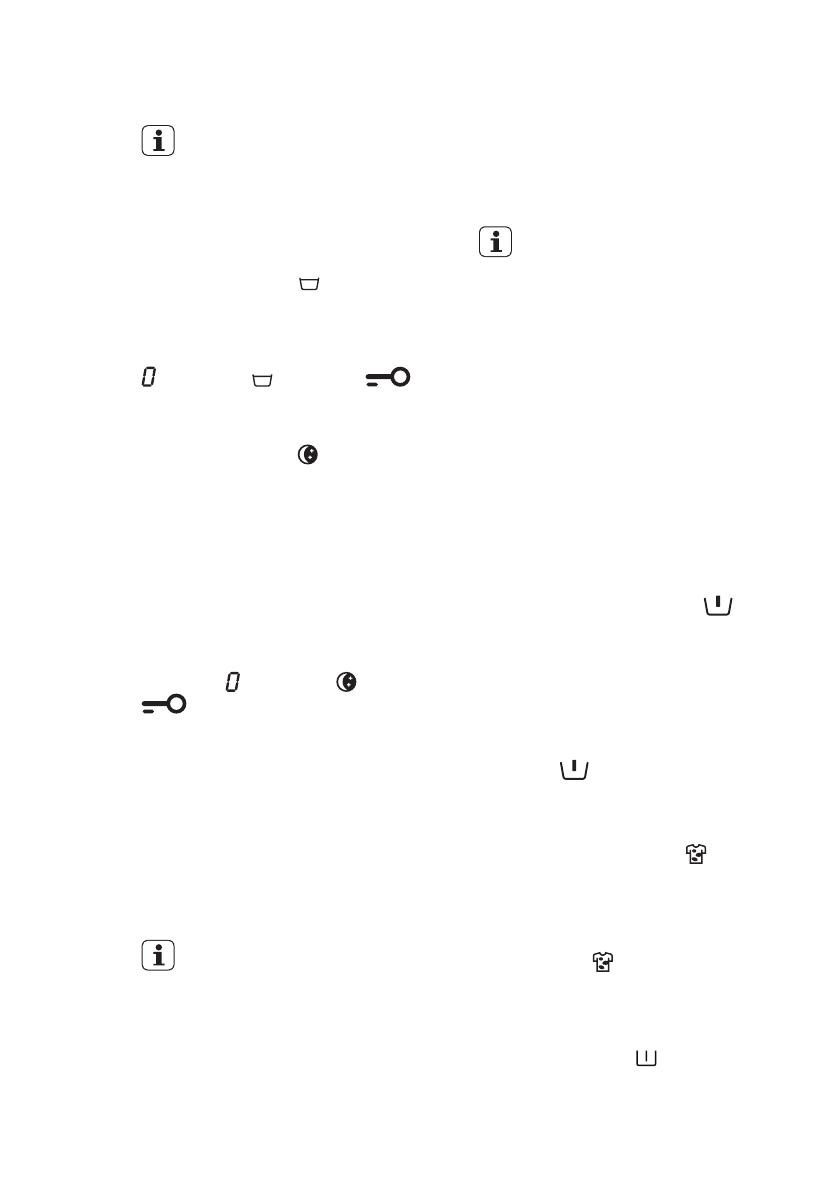
AJUSTE DE LA VELOCIDAD DE
CENTRIFUGADO (TECLA 3)
Cuando selecciona un programa,
el aparato propone de forma au-
tomática la velocidad de centrifu-
gado máxima para dicho progra-
ma.
Pulse la tecla 3 repetidamente para cam-
biar la velocidad de centrifugado.
AGUA EN LA CUBA
Al seleccionar esta opción, el agua del úl-
timo aclarado no se descarga para impe-
dir que los tejidos se arruguen. Cuando el
programa termina, en la pantalla aparece
y el símbolo , el símbolo per-
manece encendido, el piloto del botón 8
se apaga y la puerta se bloquea para indi-
car que es preciso descargar el agua.
CICLO NOCTURNO
Al seleccionar esta opción, el aparato no
descarga el agua del último aclarado para
impedir que la colada se arrugue. Todas
las fases de centrifugado se eliminan para
que el programa de lavado no haga rui-
do, de modo que se puede programar
por la noche o durante las horas en las
que la tarifa eléctrica es más económica.
En algunos programas se utiliza más agua
para los aclarados.
Cuando el programa termina, en la panta-
lla aparece
y el símbolo , el símbolo
permanece encendido, el piloto
del botón 8 se apaga y la puerta se blo-
quea para indicar que es preciso descar-
gar el agua.
Para descargar el agua, consulte el
apartado «Al final del programa».
AJUSTE DE LAS OPCIONES
(TECLA 4)
Existe la posibilidad de combinar distintas
funciones según el programa.
No todas las opciones son com-
patibles entre sí. Los símbolos de
las opciones no compatibles de-
saparecen.
Si se selecciona una opción no
compatible con el programa de
lavado configurado o cualquier
otra opción, aparece el mensaje
Err durante unos segundos y el
piloto amarillo del botón 8 co-
mienza a parpadear.
Ajuste las opciones después de elegir el
programa pero antes de pulsar el botón
8. Pulse la tecla 4: todos los símbolos de
las opciones desaparecen del indicador
Para desplazarse por las opciones dispo-
nibles, pulse el botón 4. El símbolo co-
rrespondiente aparece en la pantalla y co-
mienza a parpadear.
Consulte la compatibilidad de los
programas de lavado con las op-
ciones en el capítulo «Programas
de lavado».
CONFIRMAR SU SELECCIÓN
(TECLA 5)
Pulse la tecla 5 para activar y confirmar su
elección. Aparece un guión negro debajo
del símbolo seleccionado para indicar
que esta opción se ha establecido. Pulse
el botón 5 para desactivar la opción.
Después de ajustar las opciones, espere
unos segundos hasta que la pantalla vuel-
va a mostrar el estado predeterminado.
Los símbolos de las opciones selecciona-
das aparecen en la pantalla.
OPCIÓN PRELAVADO
Seleccione la opción PRELAVADO si de-
sea aplicar un ciclo de prelavado a 30°C
antes del lavado principal. El prelavado fi-
naliza con un breve centrifugado en pro-
gramas para algodón y tejidos sintéticos,
mientras que en el programa para tejidos
delicados el agua sólo se descarga.
El símbolo
aparece en la pantalla.
La opción de Prelavado se recomienda
para prendas muy sucias.
OPCIÓN MANCHAS
Seleccione la opción MANCHAS si desea
aplicar quitamanchas a ropa muy sucia o
con manchas (lavado principal extendido
con fase para manchas y tiempo optimiza-
do). El símbolo
aparece en la pantalla.
Esta opción no está disponible con tem-
peraturas inferiores a 40 °C
Si desea ejecutar un programa con la op-
ción MANCHAS, vierta el quitamanchas
en el compartimento
.
Las opciones PRELAVADO y MANCHAS
no se pueden seleccionar a la vez.
ESPAÑOL
49







































































